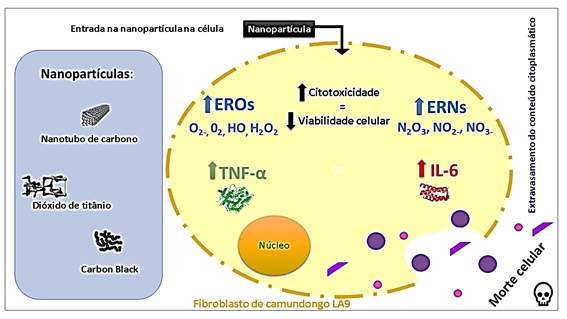


The nanoparticles were tested on a strain of mouse fibroblasts to understand the potential damage these materials could cause in the body (image: CDMF)
Published on 06/12/2024
Agência FAPESP* – Researchers from the Center for Development of Functional Materials (CDMF) and the Laboratory of Inflammation and Infectious Diseases of the Federal University of São Carlos (UFSCar), in the state of São Paulo, Brazil, have been conducting experiments on mammalian cells to evaluate the toxicity of nanoparticles that are either already used in industry or may be used in the near future.
Recently tested varieties include carbon black nanoparticles modified with ethylenediamine (CB-EDA), which are already used in the oil industry and medicine, for example; titanium dioxide (TiO2), which is used in cosmetics, food and personal hygiene products; and carbon nanotubes (OCNT-TEPA), which are expected to be used in energy storage and conversion devices, sensors, semiconductors and biotechnology.
The nanoparticles were tested on a cell line of mouse fibroblasts to understand the potential damage these materials could cause in the body. Fibroblasts were chosen for testing because they are distributed throughout the mammalian body and play an important role in inflammatory processes.
Using techniques that analyzed cell viability, oxidative stress pathways, inflammatory pathways and cell death, the group found that these nanoparticles are toxic at higher concentrations. The mechanism elucidated shows that the nanoparticles can interact with the lipids of the cell membrane using the electrons present on the surface of the nanoparticle and even penetrate the cell. This effect can generate a signal for the cell to trigger protective physiological and genetic processes.
Reactive oxygen species (ROS) are normally synthesized by the cell and are responsible for maintaining cellular homeostasis (balance). When the cell is stressed, for example by the interaction or entry of the nanoparticle, there is an increase in ROS. The same occurs with reactive nitrogen species (RNS). The increase in these leads to inhibition of mitochondrial function (cellular respiration) and an even greater increase in ROS. As a result, there is activation of repressor genes, DNA damage and synthesis of inflammatory cytokines such as TNF-α and IL-6.
The results showed that the three nanoparticles tested have the potential to cause a significant increase in the synthesis of ROS, ERNs, TNF-α and IL-6, leading to cell death by apoptosis (programmed cell death) at concentrations higher than 250 micrograms per milliliter (µg/mL) for carbon nanoparticles and higher than 10 µg/mL for titanium nanoparticles.
The research was published in the articles “Analysis of cytotoxicity and genotoxicity in a short-term dependent manner induced by a new titanium dioxide nanoparticle in murine fibroblast cells” and “New multi-walled carbon nanotube of industrial interest induces cell death in murine fibroblast cells”, both published in the journal Toxicology Mechanisms and Methods, and finally “Apoptosis and oxidative stress triggered by carbon black nanoparticle in the LA-9 fibroblast”, published in the journal Cellular Physiology and Biochemistry.
* With information from the CDMF, a FAPESP Research, Innovation and Dissemination Center (RIDC) based at UFSCar.
Source: https://agencia.fapesp.br/51947